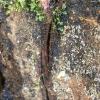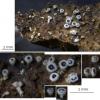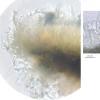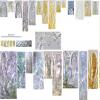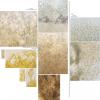
16-11-2025 21:09
 Robin Isaksson
Robin Isaksson
Anyone recognize this acc. to pictures.? Found on

18-11-2025 13:59
Nogueira HéctorNovember 14, 2025 Brazuelo (León) SPAIN Hymenosc

17-11-2025 19:14
herman lambertApothécie discoïde 0.6 cm diam., orangeFace hym�

17-11-2025 21:57
Philippe PELLICIERBonjour,Récolté sur bois de feuillu mort dur, no

17-11-2025 21:46
Philippe PELLICIERBonjour,Récolté sur bois pourrissant de feuillu

14-11-2025 16:26
 Marian Jagers
Marian Jagers
Hello everyone, On dead wood of Cytisus scoparius

15-11-2025 23:22
Mario FilippaHello,this is what I think to be Hymenoscyphus mac

15-11-2025 20:25
 Riet van Oosten
Riet van Oosten
Hello, Found by Laurens van der Linde, Nov. 2025
Looks like Eriopezia caesia
B Shelbourne,
29-03-2024 23:52
• Monotypic genus, other than E. 'phragmitis'.
• Some interesting similarities to the Polydesmia spp. that I've seen.
• Terminology used for hair-like structures:
o Marginal hairs: Shorter, antler-like, around margin.
o Flank hairs: More extensive, hypha-like, slightly thicker, often with exudate, on the receptacle and stipe.
o Anchoring hyphae: Long hyphae projecting from the flank-hairs.
o Subiculum: Extensive anchoring hyphae, forming denser mycelium, between and around the base of apothecia.
Habitat: On a sawn end of a log, ~15 cm diameter, shaded and close to the bottom of a pile, possibly hygric, unidentified deciduous wood, wood still very tough with little sign of decay, in a clearing, no bodies of water nearby, mixed deciduous woodland with mostly Quercus robur around, southern England, late March.
Associates: Pyrenomycete, bryophytes, Polydesmia pruinosa on stromatic pyrenomycete on other logs in the pile.
Apothecia: A group of several hundred, gregarious to ~10 caespitose, sessile and cupulate to short-stipitate and turbinate, appears initially globose and covered with hair, ~0.2-0.5 mm diameter, ~0.2-0.4 mm height (~0.2 without stipe), usually Q < 1 when mature, receptacle and stipe with white hairs on black background, texture firm-gelatinous; margin up to 0.1 mm wide, like receptacle, often undulating, occasionally lobate with distinct creases, often an island in the disc; hairs white, more yellowish at base of receptacle, thick, fuzzy and tangled; disk jet-black, smooth appearance, plano-concave; abundant anchoring hyphae extending from receptacle and stipe, in some areas forming a limited white subiculum similar to hairs.
Storage and methods: Stored for ~24-36 hours, sections taken from two mature looking apothecia, unfortunately not very thin so squashing required to see much detail, mounted in water, IKI or KOH + IKI added to water mount.
Asci: ~30-50 x 4.5-6 µm, 8-spored, cylindrical-clavate, IKI bb calycina shape, croziers, apex rounded-obtuse when vital and conical-truncate when dead, apical thickening noticeable when dead ~1-1.5 (3) µm high, thickening tapers gradually, pars sporifera ~30-60%, 1-2-seriate, one spore at apex, obliquely arranged, occasionally some inversely oriented spores observed towards apex, many discharging in water mount, poricidal opening, no tearing observed, often more lageniform apex after discharge, amyloid rings remaining at apex after discharge - apparently not fully retracting.
Spores: ~5-7 (8.5) x 1.5-2 µm, narrowly ellipsoid-obovoid, aseptate, usually heteropolar with the base more attenuated and acute, slightly inequilateral in profile view, often several small LBs visible (more noticeable in KOH + IKI), OCI 0-1.
Paraphyses: Narrow-filiform, ~1-1.5 µm wide, hyaline, apices rounded and uninflated, 2 septa observed, sometimes slightly flexuous, sometimes branching from 1-2 septa, occasionally antler-like, not protruding above asci, many small shadowy LBs in KOH + IKI.
Hairs: Cylindrical, apices rounded-conical, hyaline, ornamentation of small to medium amorphous warts.
• Around the margin: ~2-3.5 µm wide, extending ~50 µm, flexuous, often antler-like or propoloid.
• On the flanks and stipe: ~3-4.5 µm wide, often with yellowish-orangish exudate, often extending ~80 µm, walls appearing thick and glassy in KOH + IKI ~0.5-1.5 µm wide.
Ectal excipulum: Brownish, darker towards base, textura prismatica, narrow cells, slightly wider towards base, parallel to the surface, fading to greenish in KOH (like Mollisia).
Subhymenium and medullary excipulum: Possibly brownish (or hyaline with ectal exc. showing through), not easy to distinguish.
Basal attachment: Abundant anchoring hyphae projecting from flank hairs, similar to flank hairs.
Hans-Otto Baral,
31-03-2024 08:24

Re : Looks like Eriopezia caesia
Surely the substrate is oak, you must look for the large pores of the wood which are typical of Quercus.
Clearly this is E. caesia.

